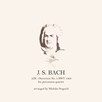
Prélude in C minor for Lute
Composer: Johann Sebastian Bach
Instrument: Percussion Duo
Level: Intermediate
Published: 2018
Price: €20.00
Item details
-
Description +
-
Duration: 5 min.
Arranged by Zoltan Kodaly / Michiko Noguchi
Performing Artists: Tatsuo Sasaki & Michiko Noguchi
This piece, which ends in G Major without returning to the home key of C Minor, was, together with the preceding BWV997, composed while Bach was living in Köthen. The entire work is a series of arpeggio figures which follow the same pattern. In this arrangement Kodály added a melody, just like Gounod did when he added his ‘Ave Maria’ melody to the somewhat repetitive arpeggios of the Prelude in C Major from Book I of the Well-Tempered Clavier.
All Bach repertoire was arranged for the purpose of recording the CD "Back to Bach" which was released in November 2017 in Tokyo.
The repertoire performed by marimba players today are mostly modern original pieces. However it is very important to get to know classical music, especially that of Bach. It is my wish to to make marimba ensemble more popular and provide music which is not too difficult technically, yet contains high artistic quality. This was my motivation to release this Bach series, Music,and CD. The title "Back to Bach" reflects this wish, and repertoire on the CD was performed by world renowned marimba performers.♪ iTunes :http://qq1q.biz/JT5D
Note: This duo can be played on two marimbas (5.0 Octave and 4.0 Octave Marimba).
Mar. 2 can be performed as a solo piece without Mar. 1.
Solo piece is the original.
Mar. 1 can be performed by any melody instrument on your choice such as violin, flute, marimba, vibraphone, etc.
Michiko Noguchi
-
-
Instrumentation +
-
This duo can be played on two marimbas (5.0 Octave and 4.0 Octave Marimba).
-
-
About the composer +
-
Johann Sebastian Bach (31 March 1685 – 28 July 1750) was a German composer and musician of the Baroque period. He enriched established German styles through his skill in counterpoint, harmonic and motivic organisation, and the adaptation of rhythms, forms, and textures from abroad, particularly from Italy and France. Bach's compositions include the Brandenburg Concertos, the Goldberg Variations, the Mass in B minor, two Passions, and over three hundred cantatas of which around two hundred survive. His music is revered for its technical command, artistic beauty, and intellectual depth.
Bach's abilities as an organist were highly respected during his lifetime, although he was not widely recognised as a great composer until a revival of interest and performances of his music in the first half of the 19th century. He is now generally regarded as one of the greatest composers of all time.
-
-
Reviews +
-
Review (Percussive Notes, August 2020)
This addition to the repertoire is a very interesting choice by Michiko Noguchi. The original piece was for lute, and the whole piece consisted of a medium-paced arpeggiated pattern. This particular prelude had a melody added to it by Zoltán Kodály. This melody is performed by the Marimba 2 player. However, the notes indicate that the melody part can be performed by any other instrument, or the Marimba 2 part can be performed as a solo.
The Marimba 1 part must be performed by someone who is comfortable playing arpeggiated figures up and down the marimba in a very smooth fashion. Four-mallet technique and a 5-octave marimba are required for this nice legato part that soars over the second part, requiring finesse for sustained rolls and meticulous phrasing.
This arrangement presents an interesting way to expose students to performing the music of Bach. It would also be an excellent way to get students performing with other instrumentalists. The possibilities for the melodic part are definitely endless. This would go well on an advanced high school or undergraduate recital. Noguchi has provided a very interesting look at Bach’s music on marimba with this arrangement.
—Josh Armstrong
-
-
Credits +
-
Front Cover graphics and layout: Ronni Kot Wenzell
Engraving: Michiko Noguchi
Printed in Copenhagen, Denmark
Copyright © 2018 Michiko Noguchi
www.editionsvitzer.com
-








